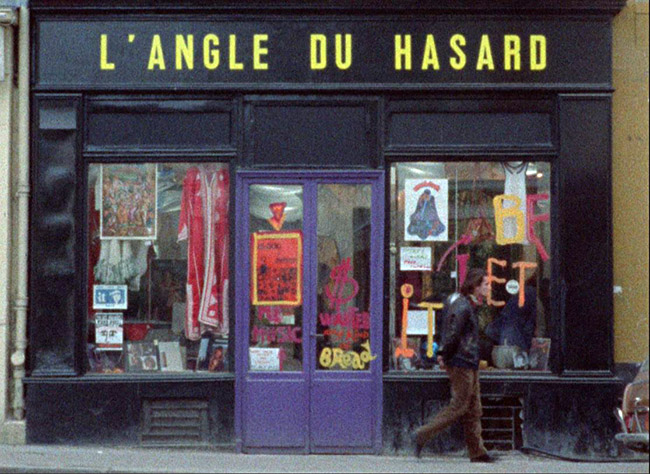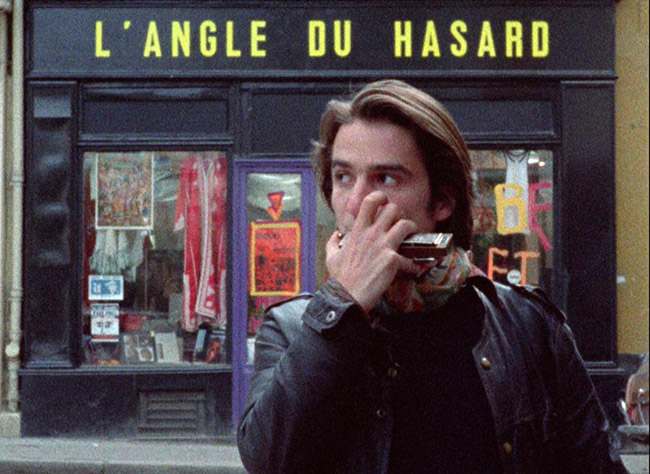
What if a film stretched as far as the eye can see? What if a film existed outside all the traditional concepts of film? In the late 60’s and early 70’s, ideas like these were on the mind of Jacques Rivette, the writer and director credited with kicking off the French New Wave with his film Paris Belongs to Us (begun, but not completed, before the first films from the Cahiers du cinéma crowd). His third film, L’amour fou (1969), broke dramatically with his earlier work, a four-hour experiment about an experimental theater group. Working with many of the same improvisational actors, he decided to make an improvisational film which would be as long as it needed to be. A film without a beginning or an end. A film that unfolded with the rhythms of real life. That became Noli Me Tangere (“Touch Me Not”), but what has more widely been called Out 1 (1971). Over the decades, the film has become a legend among cinephiles, although for most of that time span very few had actually seen it. In its final cut – which wasn’t completed by Rivette until 1990 – it is 12 hours and 55 minutes long. Shot on 16mm film, often with handheld cameras, it is almost completely improvised, the actors working within a structured and rigidly diagrammed script. But those actors were free to modify their characters as they saw fit. Rivette would go with it. The other actors would go with it. It was the spring of 1970, and Paris seemed full of possibilities – as did cinema.
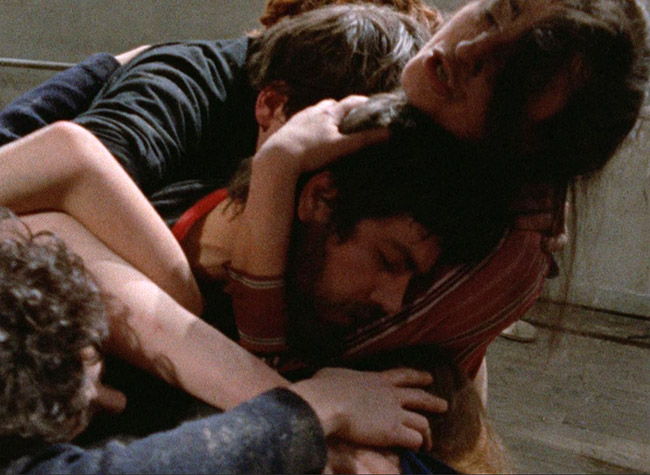
“First Episode: From Lili to Thomas”: An experimental theater troupe tests ideas for “Prometheus Bound.”
A rough cut of Out 1 was completed a year after the shooting – 12 hours, 40 minutes – and screened October 9th and 10th, 1971, at the Maison de la Culture in La Havre. This cut was rejected for broadcast on state-run French television. Rivette set to work editing a shorter version, and this cut, at a relatively brisk 4 hours and 15 minutes, became known as Out 1: Spectre. It was broadcast on German television over two nights in 1972; in 1974, the Spectre cut received a theatrical release in France. But the full-length version remained locked away until 1990, when Rivette revisited the material and edited a slightly longer version, which played in a handful of special events before being broadcast on French and German television in eight “episodes” (and thus allowing for the circulation of bootlegs for years afterward). At last, in 2013, both the Spectre and the complete Noli Me Tangere cuts of Out 1 were released on DVD in Germany, and, following a 2K restoration, it received a short art house run before its brand new debut on a lavish Blu-Ray/DVD set released this month. I’m not done watching it yet. This review will cover the first four episodes, each of which is feature length (that is, “feature length” for anyone who’s not Jacques Rivette). It’s tempting to say that viewing “Out 1” in episode format is perfectly suited to the modern Netflix era of binge watching. That would be wrong. Even in eight parts, Out 1 is clearly one long film, almost arbitrarily divided. It bears little similarity to a TV series, not even the most serialized ones like Jessica Jones or Breaking Bad. Furthermore, the fact that each episode averages 90-100 minutes means that you’ll want to take a quick jog outside if you are consuming more than one episode at a time. The experience of Out 1 begs for a different term than “binge watching.” It is not serialized entertainment. It’s experimental. It’s prickly. It requires depths of patience. And, if you’re willing to indulge, it’s a labyrinth that can easily consume you. My hat’s off to those who take in the whole thing over two nights, as the original viewers did; or, even more daring, all in one day. I had a similar experience once watching all of Béla Tarr’s 450-minute Sátántango (1994) in a dark theater with some other brave cinemanauts. I’d imagine you’d begin to lose all sense of the outside world, as I did that day, and your world would become Rivette’s. Which isn’t a bad thing.
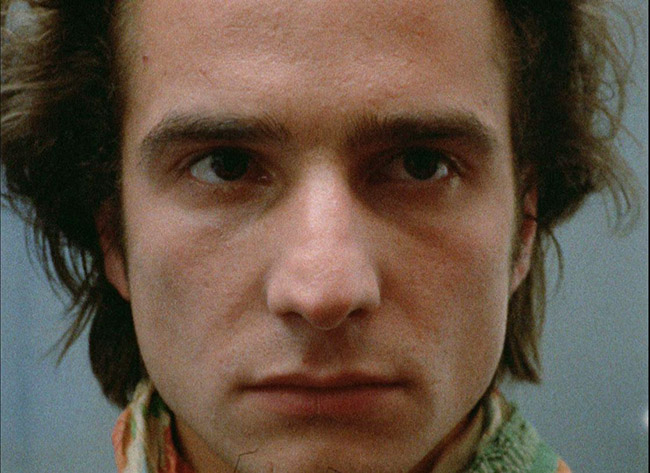
“Second Episode: From Thomas to Frédérique”: Jean-Pierre Léaud attempts to decode a pair of secret messages.
For an epic, Out 1 takes place within a very contained landscape, the Paris of 1970. The aspect ratio is a square-ish 1.37:1, and the 16mm is grainy. This isn’t David Lean. In fact, much of the first episode, “From Lili to Thomas,” takes place within the confines of empty studios where two separate acting troupes prepare for performances of plays by Aeschylus, Prometheus Bound and Seven Against Thebes. Rivette lets the camera observe as they rehearse and indulge in exercises to dig deeper into their performances, the plays’ themes, and themselves. He pushes in close as the exercises become intense, primal. He frees them of context; we don’t see them discuss what they’re about to do, which means their behavior begins with the bizarre and progresses from there. Memorably, an attempt to dig into the soul of Prometheus Bound – the story of the titan who gave fire (and knowledge) to man, and was punished for his betrayal of the gods – begins to resemble the “Dawn of Man” sequence from 2001: A Space Odyssey (1968), albeit with a surfeit of props and no makeup. Editing during these scenes is minimal, the takes long, which emphasizes immersion. The approach is that of a documentary, and gradually we begin to realize that narrative is of less importance than observing the techniques of the exercise. When the actors are finished with their performance – some laughing, some merely exhausted – they dive into analysis, and we stay with them, picking apart their performances alongside them. And from the margins creep additional characters with their own stories. There is a woman, Frédérique (Juliet Berto, of Rivette’s classic Celine and Julie Go Boating), who lurks in cafés and restaurants, flitting from one character to another whom we begin to see are marks – she’s out for cash, telling stories that we eventually realize are lies. She carries a gun in her purse. (As Godard said, “All you need is a girl and a gun.”) Then there is a deaf-mute, who will eventually be credited (in the fourth episode) as Colin. He’s played by Jean-Pierre Léaud, an iconic actor of the Nouvelle Vague (his credits include The 400 Blows, Masculin Féminin, and Stolen Kisses). At first he’s seen accosting dining gentlemen with harsh blasts from his harmonica, holding out his hand for cash. Then we see him stamping envelopes which he’s stuffed with torn-out pages from paperbacks. In the Second Episode, “From Thomas to Frédérique,” it’s revealed that he’s on a quest, having received coded messages from mysterious passers-by. He pins the two missives to a chalkboard and begins to pull references from the words. “Snark” is a reference to Lewis Carroll, so he writes “Carroll” on the board. Constant references to “thirteen” send him to a pile of books in the corner, where he retrieves Honoré de Balzac’s History of the Thirteen. The stories in the book are loosely assembled around the concept of a secret society of “The Thirteen.” Colin begins to think the Thirteen are still active in modern-day Paris.
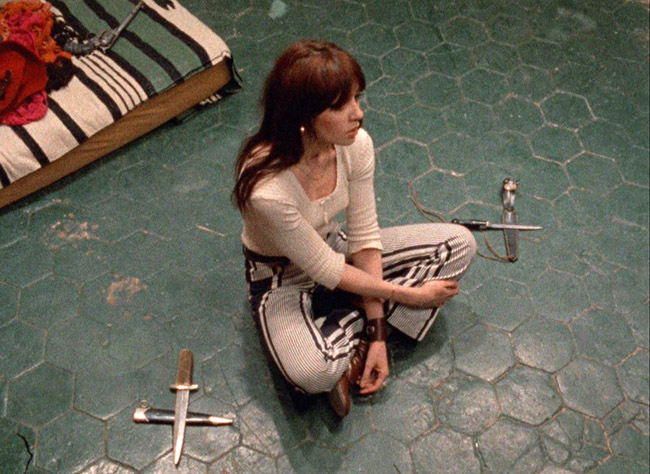
“Third Episode: From Frédérique to Sarah”: Juliet Berto as Frédérique.
Colin’s paranoia is infectious, and – as the hours pass – the viewer is encouraged to look for signs of this secret society. Could the Thirteen be the actors? (You start to count them…) Could the ominously dropped names of “Georges” and “Igor” and “Pierre” be part of the secret society? At the beginning of the Third Episode, “From Frédérique to Sarah,” Colin goes to consult a professor – played by director Éric Rohmer (Chloe in the Afternoon) – who explains everything he knows about Balzac and the Thirteen, hinting at the occult, mentioning that Balzac’s father was a Freemason, discussing the Carbonari in Italy, etc. He shows Colin a book called The Seamy Side of History. Colin tries to use Balzac as a roadmap, and comes to a shop called L’angle du hasard (“The Angle of Chance”), occupied by political radicals debating whether they should start a periodical. And we learn that Colin isn’t a deaf-mute after all, as he calls his father and uses his connections to get a press pass – all so he can infiltrate the group in the shop in hope that they can lead him to the Thirteen. Meanwhile, Frédérique continues to beg, borrow, and steal wherever she can – in her spare time playing with her gun, a pair of knives, and a harlequin doll (while she sings a song about the character archetypes of the Commedia dell’arte). In the Fourth Episode, “From Sarah to Colin,” she steals some letters and discovers a potential lead to – the Thirteen. Another storyline follows a potential member of the Thirteen, a member of the Prometheus Bound acting company, Thomas (Michael Lonsdale, Moonraker, The Phantom of Liberty). He recruits an old friend/lover named Sarah to help with their production. When she agrees to join, the acting troupes total thirteen. Following these passages, you begin to feel a bit like Leaud, wandering the streets at sharp angles, reading and memorizing his texts, intense and absurd. That’s what it’s like to be waist-deep in the waters of Jacques Rivette.
